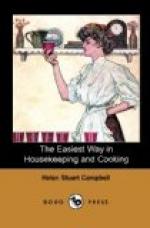RICE CROQUETTES.
Where used as a vegetable with dinner, to a pint of cold boiled rice allow a tablespoonful of melted butter and one or two well-beaten eggs. Mix thoroughly. A pinch of cayenne or a little chopped parsley may be added. Make in the shape of corks; egg and crumb, and fry a golden brown.
MACARONI.
Never wash macaroni if it can be avoided. Break in lengths of three or four inches and throw into boiling, salted water, allowing quarter of a pound for a dinner for three or four. Boil for half an hour, and drain off the water. It may be served plain with tomato sauce, or simply buttered, or with drawn butter poured over it.
MACARONI WITH CHEESE.
Boil as directed. Make a pint of white sauce or roux, as on p. 169, using milk if it can be had, though water answers. Have a cupful of good grated cheese. Butter a pudding-dish. Put in a layer of macaroni, one of sauce, and one of cheese, ending with cheese. Dust the top with sifted bread or cracker crumbs, dot with bits of butter, and bake fifteen minutes in a quick oven. It can be baked in the same way without cheese, or with simply a cup of milk and two eggs added, making a sort of pudding.
* * * * *
BREAD AND BREAKFAST CAKES.
BREAD-MAKING AND FLOUR.
Much of the health, and consequently much of the happiness, of the family depends upon good bread: therefore no pains should be spared in learning the best method of making, which will prove easiest in the end.
Yeast, flour, kneading, and baking must each be perfect, and nothing in the whole range of cooking is of such prime importance.
Once master the problem of yeast, and the first form of wheat bread, and endless varieties of both bread and breakfast cakes can be made.
The old and the new process flour—the former being known as the St. Louis, and the latter as Haxall flour—are now to be had at all good grocers; and from either good bread may be made, though that from the latter keeps moist longer. Potapsco flour is of the same quality as the St. Louis. It contains more starch than the St. Louis, and for this reason requires, even more than that, the use in the family of coarser or graham flour at the same time; white bread alone not being as nutritious or strengthening, for reasons given in Part I. Graham flour is fast being superseded by a much better form, prepared principally by the Health Food Company in New York, in which the entire grain, save the husk, is ground as fine as the ordinary flour, thus doing away with the coarseness that many have objected to in graham bread.
Flour made by the new process swells more than that by the old, and a little less quantity—about an eighth less—is therefore required in mixing and kneading. As definite rules as possible are given for the whole operation; but experience alone can insure perfect bread, changes of temperature affecting it at once, and baking being also a critical point.




